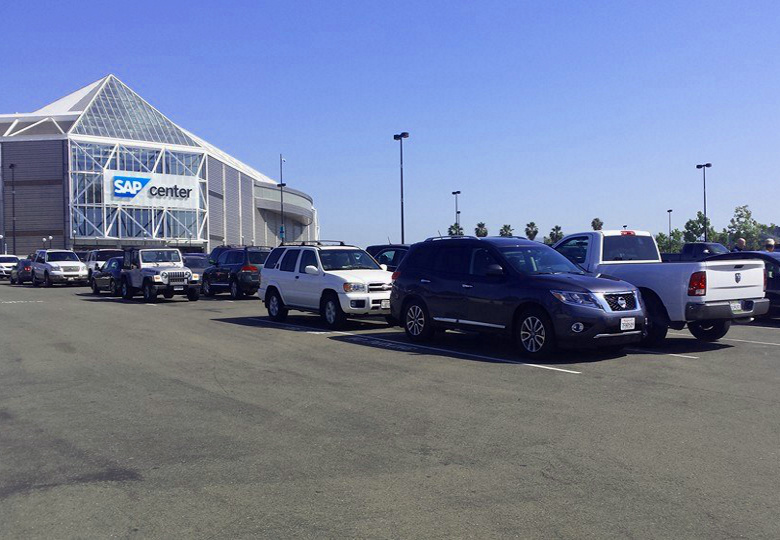Note: GJEL Accident Attorneys regularly sponsors coverage on Streetsblog San Francisco and Streetsblog California. Unless noted in the story, GJEL Accident Attorneys is not consulted for the content or editorial direction of the sponsored content.
The owners of the San Jose Sharks hockey team are opposing a proposed development in and around San Jose's Diridon Station, across the street from the SAP Center arena. The Downtown West Mixed Use Project, as the project is known, calls for safer streets, protected bike lanes, office space, and housing, but the Sharks are concerned that it will also reduce car access to SAP Center and cut into its numerous parking facilities.
From the San Jose Mercury News's coverage:
The dispute over the future parking and transit situation in the vicinity of the SAP Center, the sports and entertainment arena in downtown San Jose that is the home base of the Sharks, has begun to boil just ahead of a crucial Planning Commission vote on a development agreement for Google’s transit-oriented neighborhood.
A city analysis suggests that visitors to SAP Center will have access to more parking and transportation systems once Google’s transit-oriented neighborhood is launched and evolves to completion, according to San Jose Mayor Sam Liccardo. The transit upgrades will occur at the Diridon train station just down the street from SAP Center.
"The fundamental concerns are reasonable: they want good access to the arena and they want patrons to have a good experience," San Jose Mayor Sam Liccardo told Streetsblog. "How one defines 'access' and 'experience' depends enormously on perspective."
Liccardo noted that building a huge urban transit village with BART, Caltrain, High-Speed Rail, ACE, and VTA light rail connections should cover access. And "300,000 square feet of restaurants, retail, cafes, and bars and amenities that provide fans a reason to linger rather than to race to the nearest exit also provides a good experience--it also happens to reduce traffic congestion." The plan also calls for protected bike lanes, as part of the city's rapidly expanding network of protected bike lanes and intersections.
Nevertheless, the Sharks contend that "...the proposed project would significantly reduce the capacity of the street network to accommodate automobiles. We believe this will lead to gridlock" and therefore they want the roads leading to the Center kept wide, as written in a letter to fans. They added that "...the arena should be protected by maintaining adequate access and parking..."
The Silicon Valley Bicycle Coalition's Shiloh Ballard wrote this response in a letter to the planning commission:
...making biking infrastructure fantastic is not enough to change longstanding auto-centric habits. That is why, at the same time, the City must constrain single occupancy driving. People will default to driving unless bikes, transit, and walking are made awesome AND limits on single occupancy vehicles are put in place. This is baked into the City’s General Plan in the form of mode shift goals that reduce SOVs to 40% and increase walking and biking to 15%. The prospect of this Plan offers one of the most significant opportunities to achieve those goals.
Nevertheless, the Mayor's office wrote in an email to Streetsblog that even after the project is complete "SAP Arena will have approximately one parking space within a half-mile for every two seats in the Arena, a ratio (0.45) twice as high as other West Coast relative to sports facilities surveyed (eg, in San Francisco and Seattle)."
And: "Public investment in transit that will directly benefit Arena patrons will exceed $10 billion, if one includes BART, electrified CalTrain, High Speed Rail, and transit station improvements adjacent to the Arena."
Mayor Liccardo noted that the project will move forward with or without the Sharks' support. "Far as I know, it would be illegal to delegate the public authority of a city over land use to a private agency like the Sharks," he quipped to Streetsblog.






